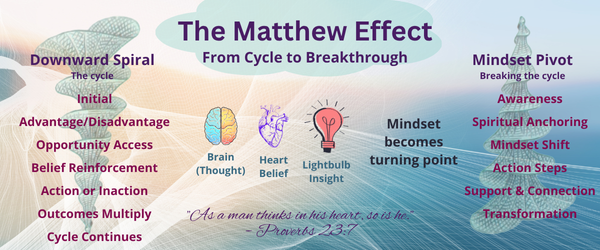Introduction
The Matthew Effect, a term coined by sociologist Robert K. Merton, originates from the Gospel of Matthew (25:29):
“For to everyone who has, more will be given, and he will have an abundance. But from the one who has not, even what he has will be taken away.”
This principle illustrates how advantage tends to accumulate advantage, while disadvantage tends to deepen disadvantage – a pattern observable across generations, cultures, and individual lives. But beyond economics or education, this concept echoes deeply through the spiritual and psychological lives of people everywhere.
-
Spiritual Perspective: The Law of Stewardship and Faith
In spiritual terms, the Matthew Effect can be interpreted as a reflection of divine principles of stewardship, responsibility, and faith. The Gospel parable does not suggest divine injustice, but rather a call to faithful use of what one has been given, whether talents, resources, or spiritual insight.
Faith multiplies faith. Those who nurture a mindset of gratitude, belief, and service often find their spiritual and emotional lives expanding. Those who bury their “talents” in fear or neglect may experience a spiritual atrophy that mirrors the Matthew Effect.
“He who is faithful in little will be faithful in much.” (Luke 16:10)
In many indigenous cultures, such as the Māori of New Zealand or the Dagara people of West Africa, spiritual teachings emphasize the responsibility to grow one’s gifts for the good of the community. A person’s spiritual wealth is communal currency.
-
Practical and Cultural Manifestations: A Global View
Across the world, the Matthew Effect plays out in tangible ways:
- United States: In education, affluent children tend to have access to better schools, extracurriculars, and parental involvement. Over time, this widens the achievement gap.
- India: The caste system, though legally abolished, perpetuates inequality. Those born into upper castes often inherit social capital, while lower castes face systemic exclusion.
- Nordic Countries: In contrast, nations like Finland and Norway actively counter the Matthew Effect through policies that ensure equal educational opportunities and healthcare access, limiting the generational transmission of privilege.
- China: The Hukou system historically restricted rural residents from accessing the same benefits as urban dwellers, deepening a rural-urban divide that mirrors the Matthew dynamic.
These examples show that social structures, combined with cultural perceptions of worth and capacity, can either intensify or resist the Matthew Effect.
-
Psychological Perspective: Perception + Belief = Reality
At its root, the Matthew Effect is fuelled by mindset. Psychologically, those who believe in their potential are more likely to take risks, invest in growth, and seek opportunity; behaviour that tends to yield more success.
Conversely, those who internalize lack or inferiority often unconsciously self-limit. This is where the effect becomes self-fulfilling:
- Self-efficacy: Believing in one’s ability increases persistence and performance.
- Confirmation bias: We notice and remember information that confirms our beliefs.
- Learned helplessness: When repeated failure is internalized, effort declines.
In spiritual psychology, this correlates with the idea that our inner world creates our outer reality. Our thoughts are not just reactions to circumstances, they shape them.
-
Breaking the Cycle: Tools to Reverse the Matthew Effect
The good news is that the Matthew Effect is not destiny. It’s a pattern. And patterns can be interrupted.
Spiritual Practices
- Gratitude journaling: Shifts focus from lack to abundance.
- Affirmations rooted in scripture or tradition: Reinforce identity beyond circumstance.
- Community service: Builds both connection and confidence.
Mindset Shifts
- Growth mindset (Carol Dweck): Failures are feedback, not verdicts.
- Visualization and goal setting: Creating a clear and emotionally compelling vision of “more.”
- Surrounding oneself with “abundant thinkers”: Environment fuels belief.
Systemic & Social Tools
- Mentorship programs: Especially for underprivileged youth.
- Access to microfinancing: Proven to lift communities out of poverty.
- Free or subsidized education and training: Closing skill and opportunity gaps.

Conclusion: Reclaiming the Spirit of the Matthew Principle
The original intent of the Matthew principle in scripture was not to shame the poor or glorify the rich, but to emphasize the sacred responsibility of growing what has been entrusted to us; be it talent, opportunity, or insight.
When spiritual awareness meets practical action, the cycle can shift. By empowering individuals to believe, act, and grow in faith and skill, we begin to break the self-reinforcing loops of inequality.
As we become more conscious, personally, culturally, and globally, we can start to make the Matthew Effect not just a cautionary tale, but a call to cultivate abundance for all.








